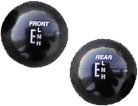| Shift
Levers
A
notable difference between the operation of the Atlas
II and the NP231 is that the Atlas II is a twin-stick
design that allows for a much greater variety of drive
configurations.
As
you can see pictured on the right, the operation of
the stock transfer case is straight forward. One swift
pull of the ergonomic lever from high range 2WD will
give you your choice of high range 4WD, Neutral, or
low range 4WD.
 The
Atlas II twin-stick setup allows six different drive
configurations, which are as follows: Neutral, 2WD High
(rear), 4WD High, 2WD Low (rear), 4WD Low, and 2WD Low
(front). The
Atlas II twin-stick setup allows six different drive
configurations, which are as follows: Neutral, 2WD High
(rear), 4WD High, 2WD Low (rear), 4WD Low, and 2WD Low
(front).
The
low range 2WD settings come in handy to reduce drivetrain
binding when one encounters tight turns on the trail.
This is particularly useful for those equipped with
locked differentials and in situations when vehicle
control is needed, but 4WD certainly isn't. 2WD low
can be disengaged at any time while driving by shifting
the respective handle into neutral. Low range can be
engaged while slowly rolling forward at a speed no faster
than 5 mph. |